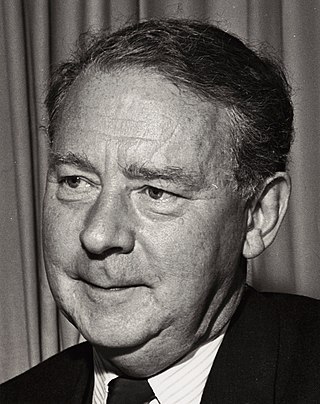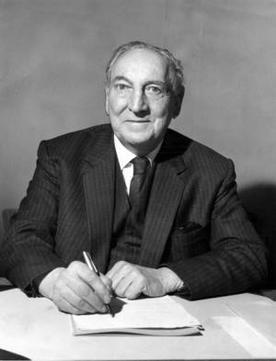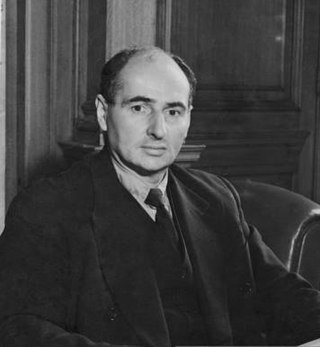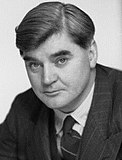Results
The day after the result was announced, the political correspondent of The Glasgow Herald reported that "Mr Griffiths's success was a foregone conclusion", but Bevan attracted a much higher vote than had been expected. He speculated that if Bevan could "keep his personal animosities under control, and restrain his tendency to quarrel with colleagues in public" he would be "a formidable contender" for the post of deputy leader if he were to challenge Griffiths the following year. [4]
As a result of Bevan's performance, his rival Gaitskell appointed him to his Shadow Cabinet as Shadow Colonial Secretary. He also won the election as party treasurer over George Brown in October 1956. One month later, he was promoted to Shadow Foreign Secretary for his fierce denunciation of the Suez Crisis. Afterwards the Bevanites and the Gaitskellites would increasingly reconcile, and Bevan was elected unopposed in the next deputy leadership election after Griffiths' retirement in 1959. [5]

Aneurin "Nye" Bevan PC was a Welsh Labour Party politician, noted for tenure as Minister of Health in Clement Attlee's government in which he spearheaded the creation of the British National Health Service. He is also known for his wider contribution to the founding of the British welfare state. He was first elected as MP for Ebbw Vale in 1929, and used his Parliamentary platform to make a number of influential criticisms of Winston Churchill and his Conservative government during the Second World War. Before entering Parliament, Bevan was involved in miner's union politics and was a leading figure in the 1926 general strike. Bevan is widely regarded as one of the most influential left-wing politicians in British history.

Hugh Todd Naylor Gaitskell was a British politician who served as Leader of the Labour Party and Leader of the Opposition from 1955 until his death in 1963. An economics lecturer and wartime civil servant, he was elected to Parliament in 1945 and held office in Clement Attlee's governments, notably as Minister of Fuel and Power following the bitter winter of 1946–47, and eventually joining the Cabinet as Chancellor of the Exchequer. Facing the need to increase military spending in 1951, he imposed National Health Service charges on dentures and spectacles, prompting the leading left-winger Aneurin Bevan to resign from the Cabinet.

James (Jeremiah) Griffiths was a Welsh Labour Party politician, trade union leader and the first Secretary of State for Wales.

Bevanism was a movement on the left wing of the Labour Party in the late 1950s led by Aneurin Bevan which also included Richard Crossman, Michael Foot and Barbara Castle. Bevanism was opposed by the Gaitskellites, moderate social democrats within the party. The Gaitskellites typically won most of the battles inside Parliament, but Bevanism was stronger among local Labour activists. The Bevanites split over the issue of nuclear weapons, and the movement faded away after Bevan died in 1960.

Emanuel Shinwell, Baron Shinwell, was a British politician who served as a government minister under Ramsay MacDonald and Clement Attlee. A member of the Labour Party, he served as a Member of Parliament (MP) for 40 years, for Linlithgowshire, Seaham and Easington respectively.

Evelyn John St Loe Strachey was a British Labour politician and writer.
The 1955 Labour Party leadership election was held following the resignation of Clement Attlee. Attlee was Prime Minister from 1945 to 1951 and stayed on as party leader until he lost the 1955 general election.
The 1960 Labour Party leadership election was held when, for the first time since 1955, the incumbent leader Hugh Gaitskell was challenged for re-election. Normally the annual re-election of the leader had been a formality. Gaitskell had lost the 1959 general election and had seen the Labour Party conference adopt a policy of unilateral nuclear disarmament which he considered disastrous and refused to support. A vacancy in the deputy leadership was first made by the death of incumbent Aneurin Bevan.
The 1963 Labour Party leadership election was held following the death of Hugh Gaitskell, party leader since 1955. He died on 18 January 1963 and was succeeded by deputy leader George Brown.
The Treasurer of the Labour Party is a position on the National Executive Committee of the British Labour Party.
The Ebbw Vale by-election on 17 November 1960 was a by-election for a single seat in the House of Commons of the United Kingdom. Caused by the death of Labour Party Deputy Leader Aneurin Bevan, the constituency was very safely held by Labour and never in significant danger of changing hands. The selection of Michael Foot, a prominent left-winger out of sympathy with the party leadership on nuclear disarmament and other issues, led to a lively campaign. Foot's handy win was seen as causing problems for party leader Hugh Gaitskell.

Gaitskellism was the ideology of a faction in the British Labour Party in the 1950s and early 1960s which opposed many of the economic policies of the trade unions, especially nationalisation and control of the economy.
The Campaign for Democratic Socialism or CDS was a social democratic and democratic socialist organisation in the British Labour Party, serving as a pressure group representing the right wing of the party. Established in 1960, the CDS was composed of Gaitskellites, Labour members who supported the then-party leader, Hugh Gaitskell.

Herbert Stanley Morrison, Baron Morrison of Lambeth, was a British politician who held a variety of senior positions in the UK Cabinet as member of the Labour Party. During the inter-war period, he was Minister of Transport during the Second MacDonald ministry, then after losing his parliamentary seat in the 1931 United Kingdom general election, he became Leader of the London County Council in the 1930s. After returning to the Commons, he was defeated by Clement Attlee in the 1935 Labour Party leadership election but later acted as Home Secretary in the wartime coalition.
The 1960 Labour Party deputy leadership election took place in November 1960, after the death of sitting deputy leader Aneurin Bevan.
The 1959 Labour Party deputy leadership election took place on 4 May 1959, after sitting deputy leader Jim Griffiths retired.
The 1953 Labour Party deputy leadership election took place on 29 October 1953, after sitting deputy leader Herbert Morrison was challenged by Aneurin Bevan.
The 1952 Labour Party deputy leadership election took place on 11 November 1952, after sitting deputy leader Herbert Morrison was challenged by Aneurin Bevan.
Elections to the Labour Party's Shadow Cabinet occurred in November 1958. In addition to the 12 members elected, the Leader, Deputy Leader, Labour Chief Whip, Labour Leader in the House of Lords, and Labour Chief Whip in the House of Lords were automatically members.
Elections to the Labour Party's Shadow Cabinet occurred in November 1959. In addition to the 12 members elected, the Leader, Deputy Leader, Labour Chief Whip, Labour Leader in the House of Lords, and Labour Chief Whip in the House of Lords were automatically members.






